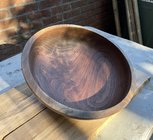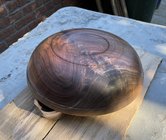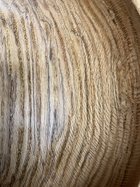As Richard said - Way to tell between red oak and white oak is nothing to do with the color of the wood - White oak has closed pores , red oak you can take a stick of wood (cut along the grain) and stick one end in water, and use it as a straw - you can suck water through the grain of red oak like it was a straw, with white oak, at the worst, it'd be like trying to suck up an extra thick milkshake through a soft plastic straw - Durn difficult!
I wouldn't try using air compressor compressed air (risk of blowing out side grain if pressure is too high) but you can indeed blow through the pores of red oak pretty easily. (Note: Red oak can look "white" , and likewise, White Oak can have reddish color to it.. so color doesn't define it... However if you get quarter sawn pieces and see similar figuring to "tiger stripes", chances are it would be white oak.. but the porosity of the end grain pores would be the definitive identifier for the most part. )
For the finish, As far as I have seen - Any bowl can be a salad bowl... Way back when. most bowls were actually unfinished - just bare wood - and there's still excellent heirloom examples of well-kept wooden bowls that never had a finish to them to begin with, and were daily use items in many households. But as far as I go, I'd use pretty much any standard curing oil such as walnut oil , polymerized linseed oil, beeswax, Carnauba Wax, mineral oil, and the like. (not boiled linseed oil that you buy at the hardware store though - as you'd note on the can, they have warnings about the chemicals in them- many "danish oils" have a polyurethane component to them... a little research into the product you want to apply would go a long way - way I approach it is, if it was relatively safe to drink/eat/etc or handle bare-handed (That is, no chemical and handling warnings on the can) , it'd be fine for a utensil / kitchenware finish.
(You know, Linseed oil is the same stuff as the flaxseed oil supplements you buy at the drug store for dietary supplements.. only difference is how the oil is processed and extracted from the Flax seed it comes from. Linseed oil extraction includes the use of petroleum distillates, I believe, while flaxseed is pretty much just pressed like extra virgin olive oil, AFAIK)





